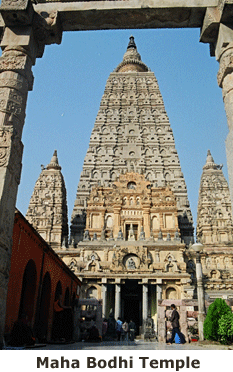MAHA BODHI TEMPLE................................................................................................................................................................................................................................................................................... Lord Gautam Buddha, when tried unsuccessfully all major means to dip deep in the reality of life, reached Bodh Gaya, denounced asceticism and attained enlightenment under the Bodhi tree. After His mahaparinirvana, all the major sites related to the Buddha's life including Bodh Gaya became pilgrimages for the Buddhists around the world. The Maha Bodhi Temple in Bodh Gaya, India is one of those four foremost sites venerated by the Buddhists as it still reveres the Buddha's enlightenment. It was here that Siddhartha realised the 'Middle Way', which subsequently became the centre of His teachings. The Maha Bodhi temple is administered by the Hindus and the Buddhist council jointly as the Hindus also consider the Buddha as a reincarnation of the Hindu deity Vishnu. Therefore, the combined contribution of both the sects presents the core of the vivid Indian culture in form of unity. The Temples Architecture The Maha Bodhi temple is believed to have been built by the great Indian emperor Ashoka in the 3rd century BCE in honour of the Buddha. The walls inside the temple are decorated with friezes depicting the Buddha's life. There is a raised walkway, known as the Chankramana Chaitya or the Jewel Path (where the Buddha meditated and walked), which is situated alongside the northern wall of the temple. Besides, there is a lotus pond along the temple, which is believed to be the place where Lord Buddha performed his ablutions. The temple has a 52 meter dome or central tower, which was renovated in the 19th century CE. The dome consists of several horizontal bands of mouldings and arch motifs, which further extend upward to an 'amalaka' with its top in umbrella-shaped forms, very much similar to those found in the early Buddhist stupas. Further, there are four similar smaller towers around the central tower, which were added to the main structure in the 19th century CE. Towards the west of the temple lies the Bodhi tree, under which the Siddhartha Gautama had achieved enlightenment and became the Buddha. The Maha Bodhi temple was renovated and extensively built in the 19th century CE, but still it did not lose its originality and remained in the same format as it was built, facing towards the east. Today, the Maha Bodhi temple is a site sacred for every Buddhist, particularly of the Theravadins, who have copied the original structure while constructing the temples in Nepal, Thailand and Myanmar. Location and Accessibility The Maha Bodhi temple is situated at Bodh Gaya, in the southern Bihar, India. Bodh Gaya is at a distance of 100 Kilometers from Patna, the capital of Bihar. By airways, it is connected directly to Colombo and Bangkok. Bodh Gaya can be reached by rail, road or air conveniently. Gaya has an important railway station with services from many parts of India. Gaya and Bodh Gaya, both are well connected by roadways to other major cities such as Patna, the state capital of Bihar and Ranchi, the state capital of Jharkhand. Bodh Gaya is connected to Gaya by regular and frequent transport services and can easily be reached within half an hour or so, as it is just 12 kilometers away. Gaya, 12 kilometers away from Bodh Gaya, is the main access station to reach Bodh Gaya. Best Time To Visit Bodh Gaya can be visited throughout the year. But the best deal is paying a visit in the months between October and March due to the pleasant weather. The Maha Bodhi temple remains open for the visitors everyday between 6 am to 12 noon and from 2 pm to 6.30 pm. |
|||||||
|
|
|||||||



 The Maha Bodhi temple, which dates back from the 3rd century
BCE till the modern times, is one of the few early
monumental brick structures to have survived in the
north-eastern India. Marked by a 52 meter tall dome and a
large gilded Buddha's statue next to the Bodhi Tree, the
temple presents a unique architectural style.
The Maha Bodhi temple, which dates back from the 3rd century
BCE till the modern times, is one of the few early
monumental brick structures to have survived in the
north-eastern India. Marked by a 52 meter tall dome and a
large gilded Buddha's statue next to the Bodhi Tree, the
temple presents a unique architectural style.
